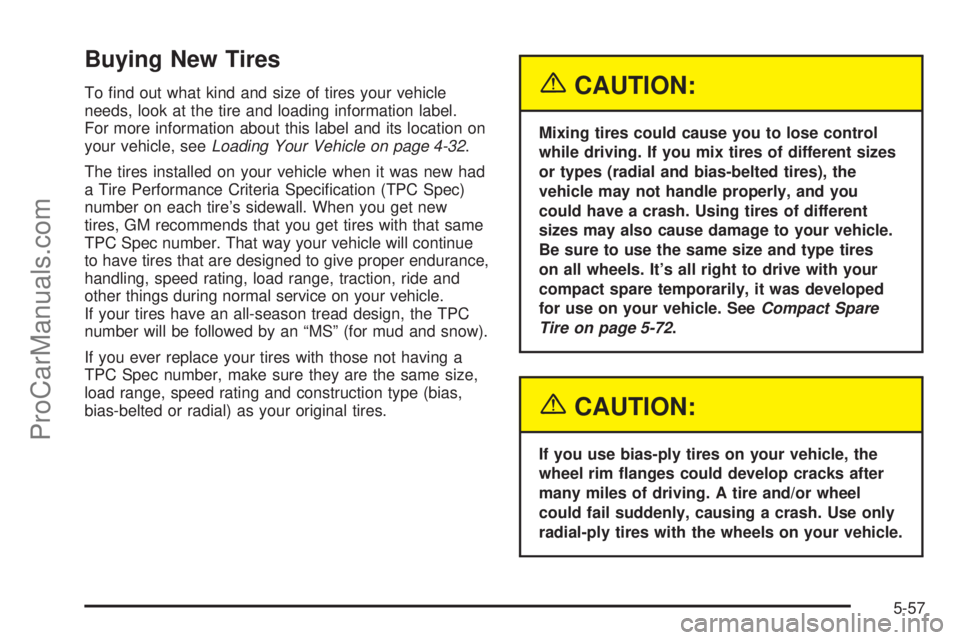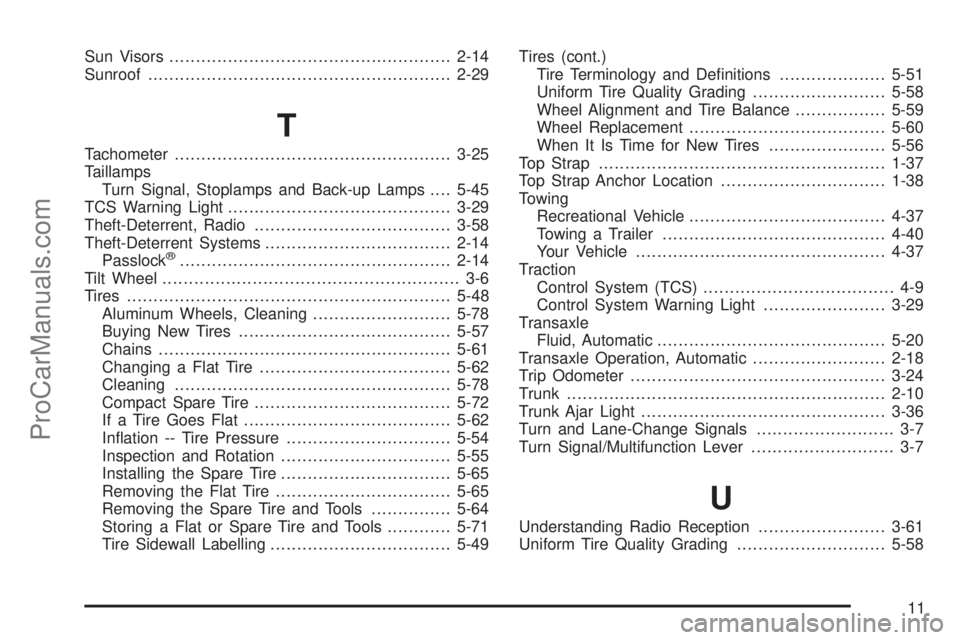traction control SATURN L-SERIES 2005 User Guide
[x] Cancel search | Manufacturer: SATURN, Model Year: 2005, Model line: L-SERIES, Model: SATURN L-SERIES 2005Pages: 330, PDF Size: 2.4 MB
Page 181 of 330

Driving on Snow or Ice
Most of the time, those places where your tires meet
the road probably have good traction.
However, if there is snow or ice between your tires and
the road, you can have a very slippery situation. You
will have a lot less traction, or grip, and will need to be
very careful.What is the worst time for this? Wet ice. Very cold snow
or ice can be slick and hard to drive on. But wet ice can
be even more trouble because it may offer the least
traction of all. You can get wet ice when it is about
freezing (32°F; 0°C) and freezing rain begins to fall.
Try to avoid driving on wet ice until salt and sand crews
can get there.
Whatever the condition — smooth ice, packed, blowing,
or loose snow — drive with caution.
Traction control improves your ability to accelerate when
driving on a slippery road. Even though your vehicle
has a traction control system, you will want to slow down
and adjust your driving to the road conditions. Under
certain conditions, you may want to turn the traction
control system off, such as when driving through deep
snow and loose gravel, to help maintain vehicle
motion at lower speeds. SeeTraction Control System
(TCS) on page 4-9.
Unless you have the anti-lock braking system, you will
want to brake very gently, too. If you do have anti-lock,
seeAnti-Lock Brake System (ABS) on page 4-7. This
system improves your vehicle’s stability when you make a
hard stop on a slippery road. Whether you have the
anti-lock braking system or not, you will want to begin
stopping sooner than you would on dry pavement.
Without anti-lock brakes, if you feel your vehicle begin to
slide, let up on the brakes a little. Push the brake pedal
down steadily to get the most traction you can.
4-27
ProCarManuals.com
Page 185 of 330

Rocking Your Vehicle to Get It Out
First, turn your steering wheel left and right. That will clear
the area around your front wheels. You should turn your
traction control system off. SeeTraction Control System
(TCS) on page 4-9. Then shift back and forth between
REVERSE (R) and a forward gear, spinning the wheels
as little as possible. Release the accelerator pedal while
you shift, and press lightly on the accelerator pedal when
the transaxle is in gear. By slowly spinning your wheels in
the forward and reverse directions, you will cause a
rocking motion that may free your vehicle. If that does not
get you out after a few tries, you may need to be towed
out. Or, you can use your recovery hook. If you do need
to be towed out, seeTowing Your Vehicle on page 4-37.
Recovery Hook
Your vehicle is equipped with a recovery hook. The
recovery hook is provided at the rear of your vehicle.
It can only be used for pulling your vehicle out.
{CAUTION:
The recovery hook, when used, is under a lot
of force. Always pull the vehicle straight out.
Never pull on the hook at a sideways angle.
The hook could break off and you or others
could be injured from the chain or cable
snapping back.
Notice:Never use the recovery hook to tow the
vehicle. Your vehicle could be damaged and it would
not be covered by warranty.
4-31
ProCarManuals.com
Page 257 of 330

Buying New Tires
To find out what kind and size of tires your vehicle
needs, look at the tire and loading information label.
For more information about this label and its location on
your vehicle, seeLoading Your Vehicle on page 4-32.
The tires installed on your vehicle when it was new had
a Tire Performance Criteria Specification (TPC Spec)
number on each tire’s sidewall. When you get new
tires, GM recommends that you get tires with that same
TPC Spec number. That way your vehicle will continue
to have tires that are designed to give proper endurance,
handling, speed rating, load range, traction, ride and
other things during normal service on your vehicle.
If your tires have an all-season tread design, the TPC
number will be followed by an “MS” (for mud and snow).
If you ever replace your tires with those not having a
TPC Spec number, make sure they are the same size,
load range, speed rating and construction type (bias,
bias-belted or radial) as your original tires.{CAUTION:
Mixing tires could cause you to lose control
while driving. If you mix tires of different sizes
or types (radial and bias-belted tires), the
vehicle may not handle properly, and you
could have a crash. Using tires of different
sizes may also cause damage to your vehicle.
Be sure to use the same size and type tires
on all wheels. It’s all right to drive with your
compact spare temporarily, it was developed
for use on your vehicle. SeeCompact Spare
Tire on page 5-72.
{CAUTION:
If you use bias-ply tires on your vehicle, the
wheel rim �anges could develop cracks after
many miles of driving. A tire and/or wheel
could fail suddenly, causing a crash. Use only
radial-ply tires with the wheels on your vehicle.
5-57
ProCarManuals.com
Page 258 of 330

Uniform Tire Quality Grading
Quality grades can be found where applicable on the
tire sidewall between tread shoulder and maximum
section width. For example:
Treadwear 200 Traction AA Temperature A
The following information relates to the system
developed by the United States National Highway
Traffic Safety Administration, which grades tires by
treadwear, traction and temperature performance.
(This applies only to vehicles sold in the United States.)
The grades are molded on the sidewalls of most
passenger car tires. The Uniform Tire Quality Grading
system does not apply to deep tread, winter-type
snow tires, space-saver or temporary use spare tires,
tires with nominal rim diameters of 10 to 12 inches
(25 to 30 cm), or to some limited-production tires.
While the tires available on Saturn passenger cars and
light trucks may vary with respect to these grades,
they must also conform to federal safety requirements
and additional General Motors Tire Performance
Criteria (TPC) standards.
Treadwear
The treadwear grade is a comparative rating based on
the wear rate of the tire when tested under controlled
conditions on a specified government test course.
For example, a tire graded 150 would wear one and
a half (1.5) times as well on the government course as
a tire graded 100. The relative performance of tires
depends upon the actual conditions of their use,
however, and may depart significantly from the norm
due to variations in driving habits, service practices and
differences in road characteristics and climate.
Traction – AA, A, B, C
The traction grades, from highest to lowest, are AA, A,
B, and C. Those grades represent the tire’s ability
to stop on wet pavement as measured under controlled
conditions on specified government test surfaces of
asphalt and concrete. A tire marked C may have poor
traction performance. Warning: The traction grade
assigned to this tire is based on straight-ahead braking
traction tests, and does not include acceleration,
cornering, hydroplaning, or peak traction characteristics.
5-58
ProCarManuals.com
Page 261 of 330

Used Replacement Wheels
{CAUTION:
Putting a used wheel on your vehicle is
dangerous. You can’t know how it’s been used
or how far it’s been driven. It could fail
suddenly and cause a crash. If you have to
replace a wheel, use a new Saturn original
equipment wheel.
Tire Chains
{CAUTION:
Don’t use tire chains. There’s not enough
clearance. Tire chains used on a vehicle
without the proper amount of clearance can
cause damage to the brakes, suspension or
other vehicle parts. The area damaged by the
tire chains could cause you to lose control of
your vehicle and you or others may be injured
in a crash.
Use another type of traction device only if its
manufacturer recommends it for use on your
vehicle and tire size combination and road
conditions. Follow that manufacturer’s
instructions. To help avoid damage to your
vehicle, drive slowly, readjust or remove the
device if it’s contacting your vehicle, and
don’t spin your wheels. If you do �nd traction
devices that will �t, install them on the
front tires.
5-61
ProCarManuals.com
Page 325 of 330

Light (cont.)
Battery Warning..........................................3-27
Brake System Warning.................................3-27
Change Engine Oil......................................3-34
Daytime Running Lamps Indicator..................3-35
Engine Coolant Temperature Warning.............3-29
Highbeam On.............................................3-35
Low Coolant Warning...................................3-30
Low Fuel Warning.......................................3-37
Low Washer Fluid Warning...........................3-36
Malfunction Indicator....................................3-31
Oil Pressure...............................................3-33
Reduced Engine Power................................3-35
Safety Belt Reminder...................................3-25
Security.....................................................3-34
Service Vehicle Soon...................................3-36
TCS Warning Light......................................3-29
Traction Control System (TCS) Warning..........3-29
Trunk Ajar..................................................3-36
Lighting
Entry.........................................................3-16
Lockout Protection............................................ 2-9
Locks
Delayed Locking........................................... 2-8
Door........................................................... 2-7Locks (cont.)
Lockout Protection......................................... 2-9
Power Door.................................................. 2-8
Programmable Automatic Door Locks............... 2-8
Rear Door Security Locks............................... 2-9
Loss of Control...............................................4-15
Low Coolant Warning Light..............................3-30
Low Fuel Warning Light...................................3-37
Low Washer Fluid Warning Light.......................3-36
Lumbar
Manual Controls............................................ 1-3
M
Maintenance Schedule
Additional Required Services........................... 6-6
At Each Fuel Fill........................................... 6-9
At Least Once a Month................................6-10
At Least Once a Year..................................6-10
Introduction.................................................. 6-2
Maintenance Footnotes.................................. 6-8
Maintenance Record....................................6-15
Maintenance Requirements............................. 6-2
Normal Maintenance Replacement Parts.........6-14
Owner Checks and Services........................... 6-9
7
ProCarManuals.com
Page 329 of 330

Sun Visors.....................................................2-14
Sunroof.........................................................2-29
T
Tachometer....................................................3-25
Taillamps
Turn Signal, Stoplamps and Back-up Lamps....5-45
TCS Warning Light..........................................3-29
Theft-Deterrent, Radio.....................................3-58
Theft-Deterrent Systems...................................2-14
Passlock
®...................................................2-14
Tilt Wheel........................................................ 3-6
Tires.............................................................5-48
Aluminum Wheels, Cleaning..........................5-78
Buying New Tires........................................5-57
Chains.......................................................5-61
Changing a Flat Tire....................................5-62
Cleaning....................................................5-78
Compact Spare Tire.....................................5-72
If a Tire Goes Flat.......................................5-62
Inflation -- Tire Pressure...............................5-54
Inspection and Rotation................................5-55
Installing the Spare Tire................................5-65
Removing the Flat Tire.................................5-65
Removing the Spare Tire and Tools...............5-64
Storing a Flat or Spare Tire and Tools............5-71
Tire Sidewall Labelling..................................5-49Tires (cont.)
Tire Terminology and Definitions....................5-51
Uniform Tire Quality Grading.........................5-58
Wheel Alignment and Tire Balance.................5-59
Wheel Replacement.....................................5-60
When It Is Time for New Tires......................5-56
Top Strap......................................................1-37
Top Strap Anchor Location...............................1-38
Towing
Recreational Vehicle.....................................4-37
Towing a Trailer..........................................4-40
Your Vehicle...............................................4-37
Traction
Control System (TCS).................................... 4-9
Control System Warning Light.......................3-29
Transaxle
Fluid, Automatic...........................................5-20
Transaxle Operation, Automatic.........................2-18
Trip Odometer................................................3-24
Trunk............................................................2-10
Trunk Ajar Light..............................................3-36
Turn and Lane-Change Signals.......................... 3-7
Turn Signal/Multifunction Lever........................... 3-7
U
Understanding Radio Reception........................3-61
Uniform Tire Quality Grading............................5-58
11
ProCarManuals.com